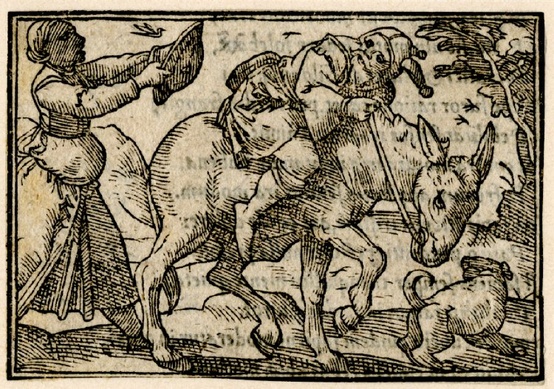In these ritualised celebrations of topsy-turvydom, the entire community was involved. The entire congregation participated, and therefore took on and embodied the inversion. "Every participant of symbolic inversion (in the ritual context) acquires significance as a sacred or elaborating symbol," (Pandian 561).
Linked to the practices of the Feast of Fools was the Feast of the Ass.
Artist Unknown | from The Feast of Fools: A Pageant of Medieval Music.
According to Harris in his book Sacred Folly:A New History of the Feast of Fools, in 1635 Pierre Louvet published a brief description of mass in the week following Christmas in Beauvais, France. Before the first vespers on the night of the Feast of the Ass, the chorus sang the following:
"Light today, the light of joy, I banish every sorrow; wherever found, be it expelled from our solemnities to-morrow. Away be strife and grief and care, from every anxious breast, and all be joy and glee in those who keep the Ass’s feast. (74-76).
Listen to "Kyrie Asini", from Feast of Fools, Phillip Pickett | New London Consort:
Lyrics: "...Lord have mercy upon us.
Ass, whose most solemn day this is, have mercy upon us.
Christ have mercy upon us.
Lord have mercy upon us.
Eeyaw have mercy upon us..."
[More about that album here]
"the birth of the son of God in a manger was a spectacular example of the world turned upside down," (Burke 193).
Harris explains that the "words of the song evoke the beauty, strength, and virtues of an ass as it journeys from the East, across the river Jordan, to Bethlehem:
Orientis partibus adventavit asinus, Out from the lands of Orient was the ass divinely sent.
pulcher et fortissimus, Strong and very fair was he, bearing burdens gallantly
sarcinis aptissimus.Hez hez sire asnes hez. Heigh, sir ass, oh heigh..." (76).
Harris describes a sanctified, though merry, parade of the ass into the church that holds with the liturgy and links the ass to the birth of Christ.
Miles, in Christmas in Ritual and Tradition, writes, "at the close of the service the priest instead of saying “Ite, missa est,” had to bray three times, and the people to respond in like manner."
Fools and Lowly Asses were often depicted together in Medieval Art:
 |
| Of Reckless Fools,Woodcut c.1568-72. Illustration to Latin edition of Sebastian Brant's 'Ship of Fools',1572. | British Museum |
 |
| Woodcut c.1568-72. | Illustration to Latin edition of Sebastian Brant's 'Ship of Fools',1572. | British Museum |

No comments:
Post a Comment